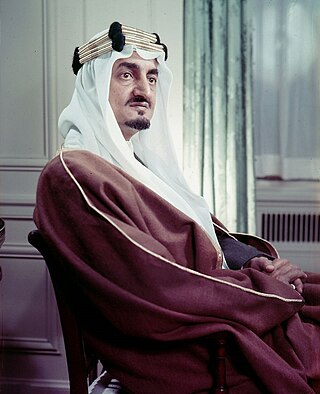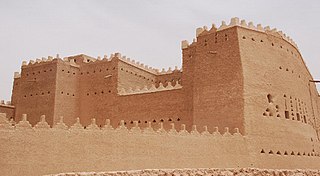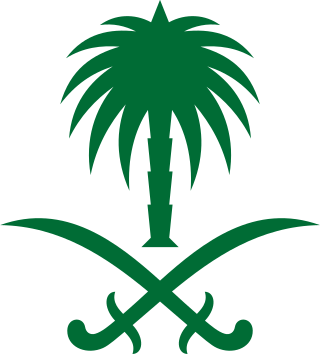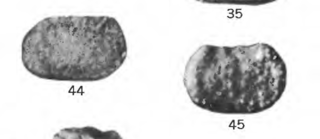
Riyadh, formerly known as Hajr al-Yamamah, is the capital and largest city of Saudi Arabia. It is also the capital of the Riyadh Province and the centre of the Riyadh Governorate.

Abdulaziz bin Abdul Rahman Al Saud, known in the West as Ibn Saud, was an Arab political and religious leader who founded Saudi Arabia – the third Saudi state – and reigned as its first king from 23 September 1932 until his death in 1953. He had ruled parts of the kingdom since 1902, having previously been Emir, Sultan, and King of Nejd, and King of Hejaz.

Faisal bin Abdulaziz Al Saud was a Saudi Arabian statesman and diplomat who was King of Saudi Arabia from 2 November 1964 until his assassination in 1975. Prior to his ascension, he served as Crown Prince of Saudi Arabia from 9 November 1953 to 2 November 1964, and he was briefly regent to his half-brother King Saud in 1964. He was prime minister from 1954 to 1960 and from 1962 to 1975. Faisal was the third son of King Abdulaziz, the founder of modern Saudi Arabia.

Saud bin Abdulaziz Al Saud was King of Saudi Arabia from 9 November 1953 until his abdication on 2 November 1964. During his reign, he served as Prime Minister of Saudi Arabia from 1953 to 1954 and from 1960 to 1962. Prior to his ascension, Saud was the country's crown prince from 11 May 1933 to 9 November 1953. He was the second son of King Abdulaziz, the founder of Saudi Arabia.

Abdul Rahman bin Faisal Al Saud was the last emir of Nejd, reigning from 1875 to 1876 and from 1889 to 1891. He was the youngest son of Emir Faisal bin Turki bin Abdullah and the father of Abdulaziz, the founder of the Kingdom of Saudi Arabia.

Sultan bin Abdulaziz Al Saud, called Sultan the Good in Saudi Arabia, was the Saudi defense minister from 1963 to 2011 and the Crown Prince of Saudi Arabia from 2005 to 2011.

Diriyah, formerly romanized as Dereyeh and Dariyya, is a town in Saudi Arabia located on the north-western outskirts of the Saudi capital, Riyadh. Diriyah was the original home of the Saudi royal family, and served as the capital of the Emirate of Diriyah under the first Saudi dynasty from 1727 to 1818. Today, the town is the seat of the Diriyah Governorate, which also includes the villages of Uyayna, Jubayla, and Al-Ammariyyah, among others, and is part of Ar Riyad Province.

Ostracods, or ostracodes, are a class of the Crustacea, sometimes known as seed shrimp. Some 70,000 species have been identified, grouped into several orders. They are small crustaceans, typically around 1 mm (0.04 in) in size, but varying from 0.2 to 30 mm in the case of Gigantocypris. Their bodies are flattened from side to side and protected by a bivalve-like valve or "shell" made of chitin, calcium carbonate and protein. The hinge of the two valves is in the upper (dorsal) region of the body. Ostracods are grouped together based on gross morphology. While early work indicated the group may not be monophyletic and early molecular phylogeny was ambiguous on this front, recent combined analyses of molecular and morphological data found support for monophyly in analyses with broadest taxon sampling.

Saud bin Faisal Al Saud, also known as Saud Al Faisal, was a Saudi Arabian statesman and diplomat who served as the foreign minister of Saudi Arabia from 1975 to 2015. A member of the Saudi royal family, he was the longest-serving foreign minister in world history.

Muhammad bin Abdulaziz Al Saud was the crown prince of Saudi Arabia from 1964 to 1965 and the nominal governor of Al Madinah Province from 1925 to 1954. He resigned as crown prince in order to pave the way for his brother Khalid bin Abdulaziz to become the heir apparent. Prince Muhammad was one of the wealthiest and most powerful members of the House of Saud. His advice was sought and deferred to in all matters by his brothers.

Articles related to Saudi Arabia include:

Bandar bin Abdulaziz Al Saud was the tenth son of King Abdulaziz. At the time of his death, he was the eldest surviving member of the ruling branch of the House of Saud.
Badr bin Abdulaziz Al Saud was a long-term deputy commander of the Saudi National Guard and a senior member of the Saudi royal family.

The Unification of Saudi Arabia was a military and political campaign in which the various tribes, sheikhdoms, city-states, emirates, and kingdoms of most of the central Arabian Peninsula were conquered by the House of Saud, or Al Saud. Unification started in 1902 and continued until 1932, when the Kingdom of Saudi Arabia was proclaimed under the leadership of Abdulaziz, known in the West as Ibn Saud, creating what is sometimes referred to as the Third Saudi State, to differentiate it from the Emirate of Diriyah, the First Saudi State and the Emirate of Nejd, the Second Saudi State, also House of Saud states.

The Ministry of Foreign Affairs is the ministry responsible for handling the Kingdom of Saudi Arabia's external relations. The ministry oversees "political, cultural and financial international relations" and monitors the Kingdom's diplomatic relations. It was created in 1930 by a royal decree issued by King Abdulaziz Al Saud, being the first ministerial body created by the King.

The Emirate of Jabal Shammar, also known as the Emirate of Haʾil or the Rashidi Emirate, was a state in the northern part of the Arabian Peninsula, including Najd, existing from the mid-nineteenth century to 1921. Jabal Shammar in English is translated as the "Mountain of the Shammar". Jabal Shammar's capital was Ha'il. It was led by the monarchy of the Rashidi dynasty. It included parts of modern-day Saudi Arabia, Iraq, and Jordan.

Mansour bin Abdulaziz Al Saud was a Saudi royal and politician who served as the defense minister of Saudi Arabia between 1943 and 1951. During his lifetime Prince Mansour was the third most powerful son of King Abdulaziz after Prince Faisal and Crown Prince Saud.
The following is a Gregorian timeline of the history for the city of Riyadh, Saudi Arabia.

Amphissites is an extinct genus of ostracod belonging to the suborder Beyrichicopina and family Amphissitinae. Species belonging to the genus lived from the Devonian to the Permian in Europe, North America, Australia, and east Asia. The genus were likely deposit-feeders, and may have survived briefly into the Triassic.

Roundyella is an extinct genus of ostracod belonging to the order Leperditellocopida and family Scrobiculidae. Specimens have been found in beds of Devonian to Triassic age in Australia, Asia, Europe, North America, and South America.

















